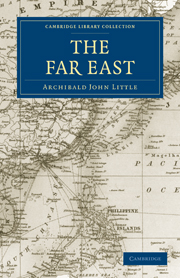Book contents
- Frontmatter
- PREFACE
- EDITORIAL NOTE
- Contents
- LIST OF MAPS AND ILLUSTRATIONS
- CHAPTER I DEFINITION
- CHAPTER II THE CENTRAL KINGDOM: CHINA
- CHAPTER III THE NORTHERN BASIN. THE YELLOW RIVER
- CHAPTER IV THE MIDDLE BASIN: PART I. THE YANGTSE RIVER
- CHAPTER V THE MIDDLE BASIN: PART II. THE PROVINCE OF SZECHUAN
- CHAPTER VI THE MIDDLE BASIN: PART III. THE CHENGTU PLATEAU
- CHAPTER VII THE MIDDLE BASIN: PART IV. THE LOWER YANGTSE PROVINCES
- CHAPTER VIII THE INTERMEDIATE PROVINCES
- CHAPTER IX THE SOUTHERN BASIN. YUNNAN TO CANTON
- CHAPTER X THE DEPENDENCIES: PART I. MANCHURIA
- CHAPTER XI THE DEPENDENCIES: PART II. MONGOLIA
- CHAPTER XII THE DEPENDENCIES: PART III. TURKESTAN
- CHAPTER XIII THE DEPENDENCIES: PART IV. TIBET
- CHAPTER XIV WHILOM DEPENDENCIES: PART I. INDO-CHINA
- CHAPTER XV WHILOM DEPENDENCIES: PART II. COREA
- CHAPTER XVI THE BUFFER KINGDOM: SIAM
- CHAPTER XVII THE ISLAND EMPIRE: JAPAN
- INDEX
- Plate section
CHAPTER IV - THE MIDDLE BASIN: PART I. THE YANGTSE RIVER
Published online by Cambridge University Press: 05 October 2010
- Frontmatter
- PREFACE
- EDITORIAL NOTE
- Contents
- LIST OF MAPS AND ILLUSTRATIONS
- CHAPTER I DEFINITION
- CHAPTER II THE CENTRAL KINGDOM: CHINA
- CHAPTER III THE NORTHERN BASIN. THE YELLOW RIVER
- CHAPTER IV THE MIDDLE BASIN: PART I. THE YANGTSE RIVER
- CHAPTER V THE MIDDLE BASIN: PART II. THE PROVINCE OF SZECHUAN
- CHAPTER VI THE MIDDLE BASIN: PART III. THE CHENGTU PLATEAU
- CHAPTER VII THE MIDDLE BASIN: PART IV. THE LOWER YANGTSE PROVINCES
- CHAPTER VIII THE INTERMEDIATE PROVINCES
- CHAPTER IX THE SOUTHERN BASIN. YUNNAN TO CANTON
- CHAPTER X THE DEPENDENCIES: PART I. MANCHURIA
- CHAPTER XI THE DEPENDENCIES: PART II. MONGOLIA
- CHAPTER XII THE DEPENDENCIES: PART III. TURKESTAN
- CHAPTER XIII THE DEPENDENCIES: PART IV. TIBET
- CHAPTER XIV WHILOM DEPENDENCIES: PART I. INDO-CHINA
- CHAPTER XV WHILOM DEPENDENCIES: PART II. COREA
- CHAPTER XVI THE BUFFER KINGDOM: SIAM
- CHAPTER XVII THE ISLAND EMPIRE: JAPAN
- INDEX
- Plate section
Summary
This middle basin of the Central Kingdom—China—is correctly defined in the words of a dispatch penned by Sir Claude Macdonald to the Chinese Foreign Office on February 19, 1898, as ‘The Yangtse region’ and the ‘provinces adjoining the Yangtse.’ A more exact definition is the ‘Yangtse basin,’ as is the definition of the northern basin we have just described—the ‘Basin of the Yellow River.’ The boundaries of the Yangtse basin are the crests of the water-partings that surround the catchment area, which area, in order to confine ourselves to the Middle Kingdom proper—the ‘eighteen provinces,’—we bring to an end in the west at the political frontier of Tibet, cutting out from our purview that upper part of the basin that lies along the higher courses of the Yangtse across the frontier. This limit, as given in modern Chinese maps, in no way corresponds with the geographical limit, the province of Szechuan; which the older maps marked as bounded on its western border by the Tatung river, and which is the true physiographical and ethnographical limit, the boundary being now made to embrace a large slice of the Tibetan plateau up to and beyond Batang: much as Yunnan, since the suppression of the Mahometan rebellion in 1875, is now made to include Atuntse and the country west of Tengyueh, nearly up to the walls of Bhamo.
- Type
- Chapter
- Information
- The Far East , pp. 53 - 68Publisher: Cambridge University PressPrint publication year: 2010First published in: 1905



